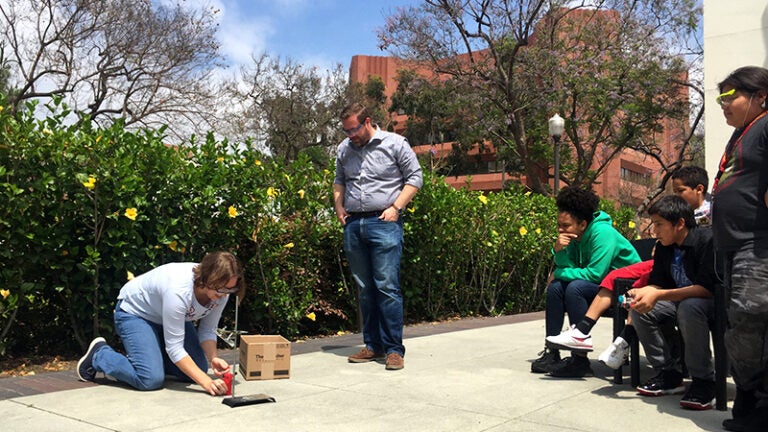
Native American students cook up chemistry fun at USC Dornsife summer camp
Want to teach the science behind green energy to middle school students? Let them build and race their own solar-powered minicars.
Excitement and anticipation were visible on the face of Brazilia Craigs, 13, as she prepared her car for the road race climax of this year’s Summer Experience in Renewable and Green Energy (SERGE), held in June.
Organized by Brent Melot, associate professor of chemistry at USC Dornsife College of Letters, Arts and Sciences, SERGE is an immersive, four-day science camp for Native American middle school students that aims to spark interest in science, technology, engineering and mathematics (STEM) education and careers.
Camp participants attend middle schools in Southern California and were recruited through a Torres Martinez Desert Cahuilla Indians outreach program that helped promote the camp and provide transportation.
“Science is cool to me,” Craigs said while making final adjustments to her rig. She and the other young participants used a 3D printer to create plastic vehicles. They then added chassis and wheels, and powered their creations with solar cell batteries, getting them ready for the big contest.
Lectures only? Nope! It’s hands-on here
“Our big goal is just making sure that students have some fun while learning,” said Melot, who is himself Native American, a member of the Citizen Potawatomi Nation of Oklahoma.
“The idea in reaching them as middle schoolers is to help them get on a science track before they begin high school,” he said.
By that measure, SERGE delivers: Craigs is one of several students who has attended the camp all three years it’s been offered. “We’ve learned something new every year, and most of the time we don’t learn this type of science in school,” she said. She expects to delve into more hands-on science this fall, attending Alliance Judy Ivie Burton Technology High School, a Los Angeles public charter school.
Campers this year did a scavenger hunt and visited the Natural History Museum of Los Angeles County.
Learning by doing helps plant seeds of interest in sustainability — including renewable energy such as solar, wind and hydro power, and battery storage — and STEM.
“Keeping their attention, that’s tricky,” Melot said. “That’s why you always have to have something tactile planned. PowerPoint presentations alone just won’t cut it.”

Brazilia Craigs prepares a solar battery-powered car for racing.
The camp’s final day also featured a test tube “gummy bear sacrifice” led by Melot and Megan Fieser, Gabilan Assistant Professor of Chemistry. When placed in a potassium chlorate solution, the sugary candy is oxidized violently, producing noise and a flame as it emits carbon dioxide and water vapor. Students cheered the demonstration, which illustrated not only how much energy is stored in food, but brought to life important chemistry principles ranging from exothermic (heat-generating) reactions to energy transformation.
Explosions for science
Nationally, college attendance among Native American students lags and has been declining since 2000, according to the Postsecondary National Policy Institute. Programs like SERGE can help reverse this trend and promote learning by enabling participants to see themselves as learners on the path to success.
Arturo Corona, 13, once aspired to become a dentist. Now he wants to become an engineer.
“He’s really enjoyed [SERGE],” said his mother, Yvonne Ojeda, a member of the Pima Navajo Nation. “He’s always thinking about things that he can make and do.” Arturo, she said, will be attending the Math and Science Academy at Cathedral High School in L.A. this fall. And his experience inspired his 11-year-old brother, Nicolas, to join SERGE as well.
Southern California has a large but widely dispersed Native American population. Melot worked with Karras Wilson, director of Native American Students Outreach and Recruitment of for the USC Native American Student Union, to connect with local communities.
“While we have many federally recognized tribes in the Los Angeles area, the trickiest part of getting the program up and going was actually trying to find Native American students to participate,” Melot said.
He credits his graduate students, including camp leader JoAnna Milam-Guerrero, with smoothly running the day-to-day camp activities while building in the fun factor.
“My goal was to get the kids interested and excited about science, so if that involves blowing things up, that’s fine,” Milan-Guerrero said. “If, while we’re having fun, I can get even the tiniest bit of science across to them, I’m happy.”
SERGE has largely grown through word-of-mouth, starting with six students in 2017, doubling in 2018 and drawing 16 participants this year. It has received support from the National Science Foundation and Research Corporation for Science Advancement to cover supplies, transportation and food.
Now the program needs new funding to keep it up and running, Melot said, and keep those solar cars on the race track.
And how did Craigs’ speedster fare? It didn’t take the trophy, but the young science enthusiast was treated to a thrilling final match-up. A tie forced a runoff race — a fitting capstone to an exciting camp experience.